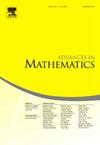非零到零曲率转换:沿无二次(拟)共振的混合曲线的算子
IF 1.5
1区 数学
Q1 MATHEMATICS
引用次数: 0
摘要
在[20]的基础上,统一研究了几种具有代表性的混合算子(即同时具有零曲率和非零曲率特征的算子)的有界性。具体来说,通过lgc方法,我们给出了三类算子的合适的Lp界:(1)carleson型算子,(2)沿变曲线的Hilbert变换,以及(3)沿曲线的双线性Hilbert变换和双线性极大算子。所有这类算子都将在没有二次共振的混合曲线的背景下进行研究。上述研究是在两个自然衍生的主题之间进行的:i)序言提供了第一个严格的描述,说明高阶调制不变性的存在/缺失如何与具有此类特征的操作符的处理方法的性质相互作用。ii)结语揭示了我们当前研究中的几个关键成分如何混合并激发一个简短的,对平滑不等式的直观新证明,平滑不等式在分析[3]中处理的三角形希尔伯特变换的曲线版本中起着核心作用。本文章由计算机程序翻译,如有差异,请以英文原文为准。
Non-zero to zero curvature transition: Operators along hybrid curves with no quadratic (quasi-)resonances
Building on [20], this paper develops a unifying study on the boundedness properties of several representative classes of hybrid operators, i.e. operators that enjoy both zero and non-zero curvature features. Specifically, via the LGC-method, we provide suitable bounds for three classes of operators: (1) Carleson-type operators, (2) Hilbert transform along variable curves, and, taking the center stage, (3) Bilinear Hilbert transform and bilinear maximal operators along curves. All these classes of operators will be studied in the context of hybrid curves with no quadratic resonances.
The above study is interposed between two naturally derived topics:
- i)A prologue providing a first rigorous account on how the presence/absence of a higher order modulation invariance property interacts with and determines the nature of the method employed for treating operators with such features.
- ii)An epilogue revealing how several key ingredients within our present study can blend and inspire a short, intuitive new proof of the smoothing inequality that plays the central role in the analysis of the curved version of the triangular Hilbert transform treated in [3].
求助全文
通过发布文献求助,成功后即可免费获取论文全文。
去求助
来源期刊

Advances in Mathematics
数学-数学
CiteScore
2.80
自引率
5.90%
发文量
497
审稿时长
7.5 months
期刊介绍:
Emphasizing contributions that represent significant advances in all areas of pure mathematics, Advances in Mathematics provides research mathematicians with an effective medium for communicating important recent developments in their areas of specialization to colleagues and to scientists in related disciplines.
 求助内容:
求助内容: 应助结果提醒方式:
应助结果提醒方式:


